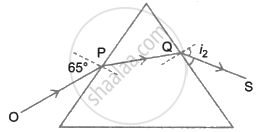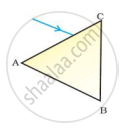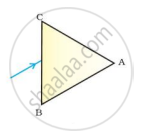Advertisements
Advertisements
प्रश्न
The deviation produced by a prism is independent of the angle of incidence and is same for all the colours of light.
विकल्प
True
False
उत्तर
This statement is False.
APPEARS IN
संबंधित प्रश्न
A light ray of yellow colour is incident on an equilateral glass prism at an angel of incidence equal to 48° and suffers minimum deviation by an angle of 36°.
- What will be the angle of emergence?
- If the angle of incidence is changes to (a) 30°, (b) 60°, state whether the angle of deviation will be equal to, less than or more than 36°?
A ray of light is normally incident on one face of an equilateral glass prism. Answer the following:
What is the angle of incidence on the first face of the prism?
A ray of light is normally incident on one face of an equilateral glass prism. Answer the following:
Will the light ray suffer minimum deviation by the prism?
In refraction of light through a prism, the light ray ______.
What should be the angle of incidence for a ray of light which suffers a minimum deviation of 36° through an equilateral prism?
[Hint: A = 60°, i = (A + δmin)/2]
Assertion: The light emerges from a parallel-sided glass slab in a direction perpendicular to that in which enters the glass slab.
Reason: The perpendicular distance between the original path of the incident ray and the emergent ray coming out of the glass slab is called lateral displacement of the emergent ray of light.
A prism ABC (with BC as base) is placed in different orientations. A narrow beam of white light is incident on the prism as shown in below Figure. In which of the following diagrams, after dispersion, the third colour from the top of the spectrum corresponds to the colour of the sky?
Explain the phenomenon of dispersion of white light through a glass prism, using suitable ray diagram.
The diagram below shows the ray OP travelling through an equilateral prism of a certain material.
- Calculate the value of i2, if the angle of deviation is 43°.
- What is the ray QS called?

The diagram below shows the path of a blue ray through the prism:
- Calculate the critical angle of the material of the prism for blue colour.
- What is the measure of the angle of this prism (A)?
- Which colour should replace the blue ray, for the ray to undergo Total Internal Reflection?





